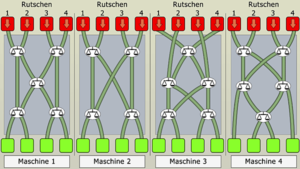The net run rate has a few disadvantages as a method of comparing performance of teams. There are three that I’ve heard or thought of.
- Team 1 gets bowled out in 33 overs having scored 230 runs. Team 2, while chasing, loses 9 wickets and reaches the target in 25 overs. Intuitively, we would think that this match was close. But because Team 1 got bowled out, its run rate calculation has 50 in the denominator, while Team will have 25, which means that NRR exaggerates the gap between them. (I think I read of this example in the feed of Twitter user ZaltzCricket)
- The bind that Pakistan found itself in recently provides another example. A team that bats first, scores 350 and dismisses its opponent for 150 rightly gets a boost to its NRR. A team that fields first, bowls out the batting team for 150 and then reaches the target in 15 overs has arguably done better than the first team, and this shows up in the run rate difference for that match. But when its net run rate is calculated over the whole tournament, the team that wins by batting second gets a disadvantage in the NRR because only 151 and 15 get added to the numerator and denominator respectively, with the result that the impact of this win is smaller than that of the team that scored 350 in 50.
- A team that scores 300 in 50 overs for the loss of 3 wickets and a team that scores 290 in 50 for 9 wickets will have nearly the same NRR, even though we intuitively feel that the number of wickets lost should also matter.
Can the Duckworth-Lewis-Stern method help fix the deficiency in the NRR? Prima Facie, it appears that the DLS method, used in its current form, should help with the problems in examples 1 and 2, but not in example 3. The idea behind DLS is that it considers the overs remaining to play and the wickets in hand as “resources” that are, statistically speaking, proportional to the runs that you can expect to score. To understand this, let’s use this table found in the Wikipedia page for DLS. It says that if your team has lost 9 wickets, unless you have fewer than 7 overs remaining, you have 4.7% of your resources left. This makes intuitive sense, because if you’ve lost 9 wickets at 40 overs, the number of overs left is not much of a constraint on how many runs you are statistically likely to score. If you have scored 200 runs at this point, DLS predicts that you are likely to score 200*100/95.3 = 210 runs.

To take another example, if, when the rain interrupts play, the team batting first has played for 25 overs without loss of wickets, DLS predicts that you still have 66.5%, or 2/3 of your resources left. If the score at this point is 125, DLS predicts that the team is likely to have scored 125*100/33.5 had it been allowed to complete its full fifty overs. If the chasing team is also given only 25 overs, it is assumed to have lost the first 25 overs of its innings, which amounts to 100-66.5, or 33.5% of its resources. So the chasing team’s score must be scaled accordingly, which means that we must compare 125*100/33.5 with S*100/66.5, where S is the chasing team’s score, to determine the winner. This is equivalent to saying that the target to chase is 125*66.5/33.5, which is how the target is given.
Going back to our three examples, it should be clear now why DLS won’t help with the third one. By definition, a team runs out of resources when it has used up 50 overs or has lost all its wickets. In example 3, both teams are at the same position as far as DLS is concerned. In examples 1 and 2, the DLS method holds more promise. Both of the situations involve a team batting second not having to bat for the full 50 overs because it reached its target score. In the first case, because the team has lost 9 wickets, DLS will predict that it will score only 231*100/95.3 =242 runs, and adjust its run rate accordingly. In the second case, assuming that the chasing team loses 5 wickets in the process of scoring 151 in 15 overs, DLS will predict that it has 48.1% of its resources left and add approximately 300 runs and 50 overs to its run rate calculation. Both these results seem fairer than using NRR as it is. Does that mean that a DLS-enriched NRR is the right option. I will give the case against followed by the case for, and let you decide.
The case against: In Oscar Wilde’s play “The Importance of Being Earnest”, there is a brilliant line that goes “I do not know whether there is anything peculiarly exciting in the air of this particular part of Hertfordshire, but the number of engagements that go on seems to me considerably above the proper average that statistics have laid down for our guidance.” The line is funny because statistics are supposed to measure reality, not guide it. It is one thing to use statistical averages as guidance in exceptional situations like rain interruptions. If we start using them for NRR calculations, we will be using them routinely. To use them to predict the score of the chasing team is particularly inappropriate. The canonical team that forms the basis for DLS is a team that is trying to score as many runs as possible within constraints of the number of overs and wickets remaining. But a team that is batting second is not aiming to score as many runs as possible. It is trying to reach its target. A team that needs to reach just 150 runs doesn’t need to bat as if it has 50 overs and 10 wickets. It can adopt a T20 strategy and score them as fast as possible. Going back to our examples, the team in the first example can protest that it is being unfairly penalized for losing wickets, when that was the right strategy in the situation. The team in the second example may benefit from DLS (because more runs and overs are added to the numerator and denominator – I think this depends on how many other matches it has played and how many other runs it has scored) but it can also argue that it is being unfairly penalized for losing 5 wickets. More pertinently, the introduction of DLS for NRR will make chasing teams completely change their strategy, which is not what we should be aiming for.
The case for: Yes, the introduction of DLS for NRR will make teams change their strategy, but that is a good thing, because now this is more of a like for like comparison. To do a perfectly fair comparison between two teams, we must put them in the exact same position. However, in a normal ODI, the team batting first does not know how much it must score; and the situation it is faced with is to score as many runs as possible within the 50 overs it has. The team batting second knows its target,and its strategy must adjust accordingly. For both teams to be in the same starting position, after the first 50 overs are done, we must inject both teams with a drug that induces amnesia and makes them forget the first 50 overs till the next 50 are completed. Unfortunately, anti-doping regulations do not allow that. Therefore, using the DLS to adjust the NRR seems like a good way to level the playing field between the two teams. Hence proved.
The case against, once again: Using DLS for NRR will slow down the batting of the second team. Any innovation that results in slower batting will never be acceptable to the ICC. Quot Erat Demonstrandum.

